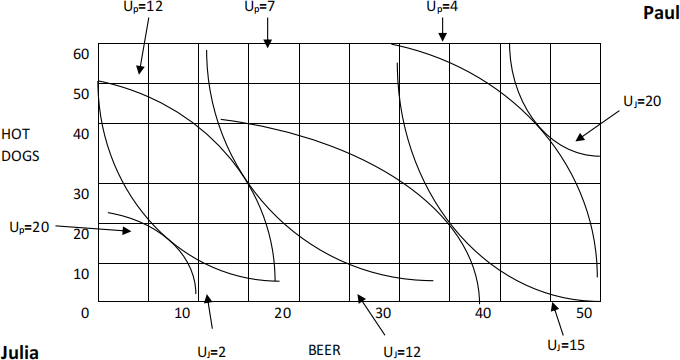Public Economics and Public Finance Practice Midterm
Hello, dear friend, you can consult us at any time if you have any questions, add WeChat: daixieit
Public Economics and Public Finance
Practice Midterm
Question 1
Below is an Edgeworth box displaying some information about Paul and Julia’s preferences. UJ=Julia’s utility, UP=Paul’s utility. Note: numbers on the axes correspond to the lines on the graph.

a) Julia has 50 hot dogs and no beer while Paul has 50 beers and 10 hot dogs. Mark this endowment point on the graph with an “X”.
b) Would Paul be willing to trade 15 beers in exchange for receiving 10 hot dogs? Would Julia accept this trade?
c) Would Paul be willing to trade 5 beers in exchange for receiving 10 hot dogs? Would Julia accept this trade?
Question 2
Adam and Lindsey love watching movies. Adam’s demand for movies is P=9-.5M where P is the price of a movie rental and M is the number of movies rented. Lindsey’s demand for movies is P=9-M. Suppose that movies cost $10 per rental. For all graphs, make sure to label all axes, intercepts, kink points, etc. for full credit.
a) Draw Adam and Lindsey’s demand curves for movies, each on their own graph.
Suppose Lindsey and Adam live in separate apartments and therefore watch movies separately (i.e., they are a private good).
b) Write down the equation for the total demand for movies given that they are a private good and draw the corresponding graph.
c) What is the equilibrium number of movies consumed in the market?
Now suppose Lindsey and Adam live in the same apartment and therefore watch movies together (i.e., movies are a public good).
d) Write down the equation for the total demand curve given that they are a public good and draw the corresponding graph.
e) What is the socially efficient number of movies watched?
Question 3
Alex is a gardener. The marginal benefit to Alex from gardening equals 75-4B, where B is the number of flowers he plants. The marginal cost of a flower equals 15 (i.e., constant marginal cost). George is Alex’s neighbor and loves the smell of flowers. The marginal external benefit to George equals 2B. How many fewer flowers will Alex plant than is socially optimal?
Question 4
There are two firms that use a production process that creates pollution. Firm 1 produces 250 units of pollution, and firm 2 produces 75. The firms have different costs for reducing pollution. The marginal cost of firm 1 to reducing pollution is MC1 = 30X1, and the marginal cost for firm 2 of reducing pollution is MC2 = 120X2, where X1 is the number of units of pollution reduction for firm 1 and X2 is the number of units of pollution reduction for firm 2.
a) Which firm is more likely to have invested in green technology which lowers costs of pollution reduction (i.e., which is the “low cost” firm)?
b) The government wants to set an emission fee such that the total number of units of pollution does not exceed 60 units. How much should each firm reduce their pollution by to be cost effective?
Question 5
Suppose you spend your money on two goods: food and everything else. Right now, you have an income of $600 per month. Compare two alternative welfare programs in which you could participate: program A would provide you with a monthly check of $300 and program B would provide you with $400 a month in credits that can be spent only on food.
a. Draw your budget constraint in each of these two cases with spending on food on the x-axis and spending on all other goods on the y-axis. Make sure to mark all intercepts and other important points. Draw both budget constraints on the same graph.
b. Draw representative indifference curves that would reflect each of these three scenarios. Draw each case on a separate graph for clarity (don’t worry about marking all intercepts like you did in part A – just a sketch will be fine).
i. You prefer program A to program B.
ii. You prefer program B to program A.
iii. You are indifferent between the two programs.
Question 6
In class we discussed the debate over the pros and cons of public education versus education vouchers that could be used at any school. Limit your answer to 1-2 sentences.
a. List one reason why providing vouchers may be a better policy than offering public education.
b. List one reason why providing vouchers may be a worse policy than offering public education.
2024-03-14